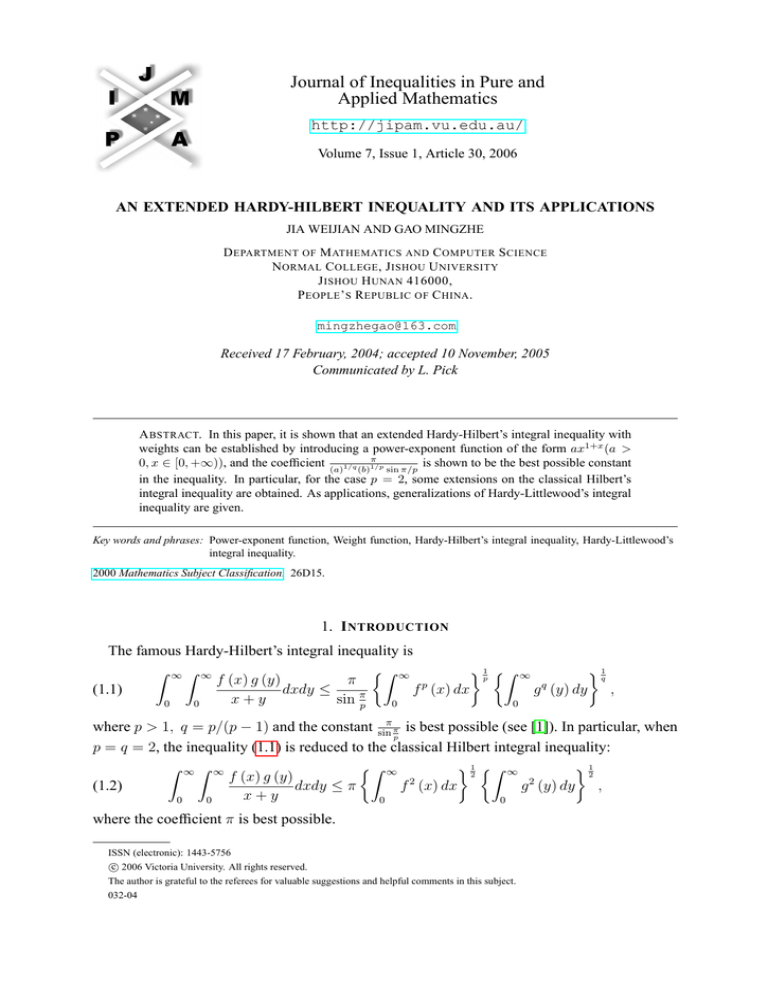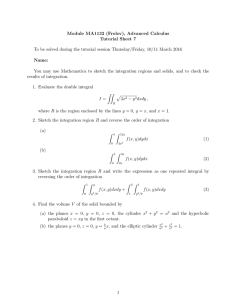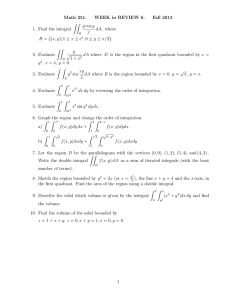
Journal of Inequalities in Pure and
Applied Mathematics
http://jipam.vu.edu.au/
Volume 7, Issue 1, Article 30, 2006
AN EXTENDED HARDY-HILBERT INEQUALITY AND ITS APPLICATIONS
JIA WEIJIAN AND GAO MINGZHE
D EPARTMENT OF M ATHEMATICS AND C OMPUTER S CIENCE
N ORMAL C OLLEGE , J ISHOU U NIVERSITY
J ISHOU H UNAN 416000,
P EOPLE ’ S R EPUBLIC OF C HINA .
mingzhegao@163.com
Received 17 February, 2004; accepted 10 November, 2005
Communicated by L. Pick
A BSTRACT. In this paper, it is shown that an extended Hardy-Hilbert’s integral inequality with
weights can be established by introducing a power-exponent function of the form ax1+x (a >
π
0, x ∈ [0, +∞)), and the coefficient (a)1/q (b)1/p
is shown to be the best possible constant
sin π/p
in the inequality. In particular, for the case p = 2, some extensions on the classical Hilbert’s
integral inequality are obtained. As applications, generalizations of Hardy-Littlewood’s integral
inequality are given.
Key words and phrases: Power-exponent function, Weight function, Hardy-Hilbert’s integral inequality, Hardy-Littlewood’s
integral inequality.
2000 Mathematics Subject Classification. 26D15.
1. I NTRODUCTION
The famous Hardy-Hilbert’s integral inequality is
1q
Z ∞
p1 Z ∞
Z ∞Z ∞
f (x) g (y)
π
p
q
g (y) dy
,
(1.1)
dxdy ≤
f (x) dx
x+y
sin πp
0
0
0
0
where p > 1, q = p/(p − 1) and the constant sinπ π is best possible (see [1]). In particular, when
p
p = q = 2, the inequality (1.1) is reduced to the classical Hilbert integral inequality:
Z ∞
12 Z ∞
12
Z ∞Z ∞
f (x) g (y)
2
2
(1.2)
dxdy ≤ π
f (x) dx
g (y) dy ,
x+y
0
0
0
0
where the coefficient π is best possible.
ISSN (electronic): 1443-5756
c 2006 Victoria University. All rights reserved.
The author is grateful to the referees for valuable suggestions and helpful comments in this subject.
032-04
2
J IA W EIJIAN
AND
G AO M INGZHE
Recently, the following result was given by introducing the power function in [2]:
Z bZ b
f (x) g (y)
dxdy
(1.3)
xt + y t
a
a
p1 1q
Z b
Z b
≤ ω (t, p, q)
x1−t f p (x) dx
ω (t, q, p)
x1−t g q (x) dx ,
a
a
where t is a parameter which is independent of x and y, ω (t, p, q) =
function ϕ is defined by
Z a/b t−2+1/r
u
du, r = p, q.
ϕ (r) =
1 + ut
0
π
t sin
π
pt
− ϕ (q) and here the
However, in [2] the best constant for (1.3) was not determined.
Afterwards, various extensions on the inequalities (1.1) and (1.2) have appeared in some
papers (such as [3, 4] etc.). The purpose of the present paper is to show that if the denominator
x + y of the function on the left-hand side of (1.1) is replaced by the power-exponent function
π
ax1+x +by 1+y , then we can obtain a new inequality and show that the coefficient (a)1/q (b)1/p
sin π/p
is the best constant in the new inequality. In particular if p = 2 then several extensions of
(1.2) follow. As its applications, it is shown that extensions on the Hardy-Littlewood integral
inequality can be established.
Throughout this paper we stipulate that a > 0 and b > 0.
For convenience, we give the following lemma which will be used later.
x
Lemma 1.1. Let h (x) = 1+x+x
, x ∈ (0, +∞), then there exists a function ϕ (x) 0 ≤ ϕ (x) <
ln x
1
such that h (x) = 2 − ϕ (x).
Proof. Consider the function defined by
s (x) =
1+x
+ ln x,
x
x ∈ (0, +∞).
It is easy to see that the minimum of s (x) is 2. Hence s (x) ≥ 2, and h (x) = s−1 (x) ≤ 12 .
1
> 0. We can define a nonnegative function ϕ by
Obviously h (x) = s(x)
ϕ (x) =
(1.4)
Hence we have h (x) =
1
2
1 − x + x ln x
2 (1 + x + x ln x)
x ∈ (0, +∞) .
− ϕ (x). The lemma follows.
2. M AIN R ESULTS
Define a function by
ω (r, x) = x
(2.1)
(1+x)(1−r)
r−1
1
− ϕ (x)
2
x ∈ (0, +∞),
where r > 1 and ϕ (x) is defined by (1.4).
Theorem 2.1. Let
Z ∞
0<
ω (p, x) f p (x) dx < +∞,
0
J. Inequal. Pure and Appl. Math., 7(1) Art. 30, 2006
Z
0<
∞
ω (q, x) g q (x) dx < +∞,
0
http://jipam.vu.edu.au/
1
2
,
A N E XTENDED H ARDY-H ILBERT I NEQUALITY AND I TS A PPLICATIONS
3
the weight function ω (r, x) is defined by (2.1), p1 + 1q = 1, and p ≥ q > 1. Then
Z ∞Z ∞
f (x) g (y)
(2.2)
dxdy
ax1+x + by 1+y
0
0
Z ∞
p1 Z ∞
1q
µπ
q
p
ω (p, x) f (x) dx
ω (q, x) g (x) dx ,
≤
sin πp
0
0
where µ = (1/a)1/q (1/b)1/p and the constant factor
µπ
sin π
p
is best possible.
1
1
0
0
Proof. Let f (x) = F (x) (ax1+x ) q and g (y) = G (y) (by 1+y ) p . Define two functions
by
1
1
0 F (x) (by 1+y ) p ax1+x pq
(2.3)
and
α=
1
1+y
(ax1+x + by 1+y ) p by
1
1
0 G (y) (ax1+x ) q by 1+y pq
β=
.
1
1+x
(ax1+x + by 1+y ) q ax
Let us apply Hölder’s inequality to estimate the right hand side of (2.2) as follows:
Z ∞Z ∞
Z ∞Z ∞
f (x) g (y)
dxdy =
(2.4)
αβdxdy
ax1+x + by 1+y
0
0
0
0
Z ∞ Z ∞
p1 Z ∞ Z ∞
1q
p
q
≤
α dxdy
.
β dxdy
0
0
0
0
It is easy to deduce that
1+x 1q
Z ∞Z ∞
Z ∞Z ∞
0
(by 1+y )
ax
p
α dxdy =
F p (x) dxdy
1+x
1+y
1+y
ax
+ by
by
0
0
Z0 ∞ 0
=
ωq F p (x) dx.
0
We compute the weight function ωq as follows:
1+x 1q
Z ∞
0
(by 1+y )
ax
ωq =
dy
ax1+x + by 1+y by 1+y
0
1+x 1q
Z ∞
1
ax
1+y
=
d
by
.
ax1+x + by 1+y by 1+y
0
Let t = by 1+y /ax1+x . Then we have
1q
Z ∞
1
1
π
π
ωq =
dt =
.
π =
1+t t
sin q
sin πp
0
0 −1/q
Notice that F (x) = (ax1+x )
f (x). Hence we have
Z ∞Z ∞
Z ∞
1−p p
π
p
1+x 0
(2.5)
α dxdy =
ax
f (x) dx,
sin πp 0
0
0
and ,similarly,
Z
∞
Z
(2.6)
0
0
∞
π
β dxdy =
sin πp
q
J. Inequal. Pure and Appl. Math., 7(1) Art. 30, 2006
Z
∞
by 1+y
0 1−q
g q (y) dy.
0
http://jipam.vu.edu.au/
4
J IA W EIJIAN
G AO M INGZHE
AND
Substituting (2.5) and (2.6) into (2.3), we obtain
Z
∞
∞
Z
(2.7)
0
0
f (x) g (y)
π
dxdy
≤
ax1+x + by 1+y
sin πp
∞
Z
ax
1−p
1+x 0
p1
p
f (x) dx
0
Z
×
∞
by
1−q
1+y 0
q
g (y) dy
1q
.
0
We need to show that the constant factor sinπ π contained in (2.7) is best possible.
p
Define two functions by
(
0,
x ∈ (0, 1)
f˜ (x) =
−(1+ε)/p
0
(ax1+x )
(ax1+x ) , x ∈ [1, +∞)
and
(
Assume that 0 < ε <
Z +∞ q
2p
ax
y ∈ (0, 1)
0,
g̃ (y) =
−(1+ε)/q
(by 1+y )
0
(by 1+y ) , y ∈ [1, +∞)
.
(p ≥ q > 1). Then
1−p
1+x 0
f˜p (x) dx =
0
Z
+∞
ax1+x
−1−ε
1
1
d ax1+x = .
ε
Similarly, we have
Z
∞
0
If
π
sin π
p
by 1+y
0 1−q
1
g̃ q (y) dy = .
ε
is not best possible, then there exists k > 0, k <
Z
∞
Z
(2.8)
0
0
∞
π
sin π
p
such that
Z ∞ p1
1−p p
f˜ (x) g̃ (y)
1+x 0
dxdy < k
ax
f˜ (x) dx
ax1+x + by 1+y
0
Z ∞ 1q
1−q q
k
1+y 0
×
by
g̃ (y) dy
= .
ε
0
On the other hand, we have
Z ∞Z ∞ ˜
f (x) g̃ (y)
dxdy
1+x + by 1+y
0
0 ax
n
on
o
1+ε
1+x 0
1+y − q
1+y 0
Z ∞ Z ∞ (ax1+x )− 1+ε
p
(ax )
(by )
(by )
=
dxdy
ax1+x + by 1+y
1
1
)
Z ∞ (Z ∞
− 1+ε
n
1+ε
o
(by 1+y ) q
1+x − p
1+y
1+x 0
=
d
by
ax
ax
dx
ax1+x + by 1+y
1
1
)
− 1+ε
Z ∞ (Z ∞
q
−1−ε
1
1
=
dt ax1+x
d ax1+x
t
1
b/ax1+x 1 + t
− 1+ε
Z
q
1 ∞
1
1
=
dt.
ε b/ax1+x 1 + t t
J. Inequal. Pure and Appl. Math., 7(1) Art. 30, 2006
http://jipam.vu.edu.au/
A N E XTENDED H ARDY-H ILBERT I NEQUALITY AND I TS A PPLICATIONS
5
If the lower limit b/ax1+x of this integral is replaced by zero, then the resulting error is smaller
α
(b/ax1+x )
than
, where α is positive and independent of ε. In fact, we have
α
1+ε
Z b/ax1+x
Z b/ax1+x
β
1
1 q
(b/ax1+x )
−(1+ε)/q
dt <
t
dt =
1+t t
β
0
0
where β = 1 − (1 + ε)/q. If 0 < ε <
q
,
2p
then we may take α such that
α=1−
Consequently, we get
Z ∞Z
(2.9)
0
∞
0
1 + q/2p
1
= .
q
2p
f˜ (x) g̃ (y)
1
dxdy >
1+x
1+y
ax
+ by
ε
(
π
+ o (1)
sin πp
)
(ε → 0).
Clearly, when ε is small enough, the inequality (2.7) is in contradiction with (2.9). Therefore,
π
is the best possible value for which the inequality (2.7) is valid.
sin π
p
Let u = ax1+x and v = by 1+y . Then
1+x
0
1+x
+ ln x = ax1+x h−1 (x) .
u = ax
x
Similarly, we have v 0 = by 1+y h−1 (y). Substituting them into (2.7) and then using Lemma 1.1,
µπ
the inequality (2.2) yields after simplifications. The constant factor sin
π is best possible, where
p
1/q
µ = (1/a)
1/p
(1/b)
. Thus the proof of the theorem is completed.
It is known from (2.1) that
r−1 r−1
1
1
ω (r, x) = x
− ϕ (x)
=
x(1+x)(1−r) (1 − 2ϕ (x))r−1 .
2
2
The following result is equivalent to Theorem 2.1.
(1+x)(1−r)
Theorem 2.2. Let ϕ (x) be a function defined by (1.4), p1 + 1q = 1 and p ≥ q > 1. If
Z ∞
0<
x(1+x)(1−p) (1 − 2ϕ (x))p−1 f p (x) dx < +∞ and
Z0 ∞
0<
y (1+y)(1−q) (1 − 2ϕ (y))q−1 g q (y) dy < +∞,
0
then
Z
∞
Z
(2.10)
0
0
∞
f (x) g (y)
dxdy
ax1+x + by 1+y
Z ∞
p1
µπ
p−1 p
(1+x)(1−p)
≤
x
(1 − 2ϕ (x)) f (x) dx
2 sin πp
0
Z ∞
1q
q−1 q
(1+y)(1−q)
×
y
(1 − 2ϕ (y)) g (y) dy ,
0
where µ = (1/a)1/q (1/b)1/p and the constant factor
µπ
2 sin π
p
is best possible.
In particular, for case p = 2, some extensions on (1.2) are obtained. According to Theorem
2.1, we get the following results.
J. Inequal. Pure and Appl. Math., 7(1) Art. 30, 2006
http://jipam.vu.edu.au/
6
J IA W EIJIAN
AND
G AO M INGZHE
Corollary 2.3. If
∞
1
0<
x
− ϕ (x) f 2 (x) dx < +∞
2
0
Z ∞
1
−(1+y)
0<
y
− ϕ (y) g 2 (y) dy < +∞,
2
0
Z
−(1+x)
and
where ϕ (x) is a function defined by (1.4), then
Z ∞
12
Z ∞Z ∞
π
1
f (x) g (y)
− ϕ (x) f 2 (x) dx
(2.11)
dxdy ≤ √
x−(1+x)
2
ax1+x + by 1+y
ab
0
0
0
Z ∞
12
1
−(1−y)
2
×
y
− ϕ (y) g (y) dy ,
2
0
where the constant factor √πab is best possible.
Corollary 2.4. Let ϕ (x) be a function defined by (1.4). If
Z ∞
1
−(1+x)
0<
− ϕ (x) f 2 (x) dx < +∞,
x
2
0
then
Z ∞
Z ∞Z ∞
f (x) f (y)
π
1
−(1+x)
(2.12)
dxdy ≤ √
x
− ϕ (x) f 2 (x) dx,
1+x + by 1+y
ax
2
ab
0
0
0
where the constant factor √πab is best possible.
A equivalent proposition of Corollary 2.3 is:
Corollary 2.5. Let ϕ (x) be a function defined by (1.4),
Z ∞
0<
x−(1+x) (1 − 2ϕ (x)) f 2 (x) dx < +∞
Z0 ∞
0<
y −(1+y) (1 − 2ϕ (y)) g 2 (y) dy < +∞,
and
0
then
Z
∞
∞
Z
(2.13)
0
0
f (x) g (y)
π
dxdy ≤ √
1+x
1+y
ax
+ by
2 ab
12
∞
Z
x
−(1+x)
2
(1 − 2ϕ (x)) f (x) dx
0
Z
∞
×
y
−(1+y)
2
(1 − 2ϕ (y)) g (y) dy
12
,
0
where the constant factor
π
√
2 ab
is best possible.
Similarly, an equivalent proposition to Corollary 2.4 is:
Corollary 2.6. Let ϕ (x) be a function defined by (1.4). If
Z ∞
0<
x−(1+x) (1 − 2ϕ (x)) f 2 (x) dx + ∞,
0
then
Z
∞
Z
∞
f (x) f (y)
π
(2.14)
dxdy ≤ √
1+x
1+y
ax
+ by
2 ab
0
0
π
where the constant factor 2√ab is best possible.
J. Inequal. Pure and Appl. Math., 7(1) Art. 30, 2006
Z
∞
x−(1+x) (1 − 2ϕ (x)) f 2 (x) dx,
0
http://jipam.vu.edu.au/
A N E XTENDED H ARDY-H ILBERT I NEQUALITY AND I TS A PPLICATIONS
7
3. A PPLICATION
In this section, we will give various extensions of Hardy-Littlewood’s integral inequality.
Let f (x) ∈ L2 (0, 1) and f (x) 6= 0. If
Z 1
an =
xn f (x) dx, n = 0, 1, 2, . . .
0
then we have the Hardy-Littlewood’s inequality (see [1]) of the form
Z 1
∞
X
2
(3.1)
an < π
f 2 (x) dx,
0
n=0
where π is the best constant that keeps (3.1) valid. In our previous paper [5], the inequality (3.1)
was extended and the following inequality established:
Z ∞
Z 1
2
(3.2)
f (x) dx < π
h2 (x) dx,
0
0
R1
where f (x) = 0 tx h (x) dx, x ∈ [0, +∞).
Afterwards the inequality (3.2) was refined into the form in the paper [6]:
Z ∞
Z 1
2
(3.3)
f (x) dx ≤ π
th2 (t) dt.
0
0
We will further extend the inequality (3.3), some new results can be obtained by further
extending inequality (3.3).
Theorem 3.1. Let h (t) ∈ L2 (0, 1), h (t) 6= 0. Define a function by
Z 1
f (x) =
tu(x) |h (t)| dt, x ∈ [0, +∞),
0
where u (x) = x . Also, let ϕ (x) be a weight function defined by (1.4), (r = p, q), p1 + 1q = 1
and p ≥ q > 1. If
r−1
Z ∞
1
(1+x)(1−r)
0<
x
− ϕ (x)
f r (x) dx < +∞,
2
0
1+x
then
Z
(3.4)
∞
f 2 (x) dx
2
0
where the constant factor
! p1
p−1
1
x(1+x)(1−p)
− ϕ (x)
f p (x) dx
2
0
Z ∞
1q Z 1
1
(1+y)(1−q)
q
×
y
− ϕ (y) f (y) dy
th2 (t) dt,
2
0
0
µπ
<
sin πp
µπ
sin π
p
Z
∞
in (3.4) is best possible, and µ = (1/a)1/q (1/b)1/p .
Proof. Let us write f 2 (x) in the form:
2
Z
f (x) =
1
f (x) tu(x) |h (t)| dt.
0
J. Inequal. Pure and Appl. Math., 7(1) Art. 30, 2006
http://jipam.vu.edu.au/
8
J IA W EIJIAN
AND
G AO M INGZHE
We apply, in turn, Schwarz’s inequality and Theorem 2.1 to obtain
Z ∞
2 Z ∞ Z 1
2
2
u(x)
f (x) dx =
f (x) t
|h (t)| dt dx
0
0
Z
0
1
Z
∞
u(x)−1/2
=
f (x) t
Z
0
0
1 Z ∞
1/2
dx t
2
Z
1
dx dt
th2 (t) dt
0
0
0
Z ∞
Z 1
Z 1 Z ∞
u(x)−1/2
u(y)−1/2
=
f (x) t
dx
f (y) t
dy dt
th2 (t) dt
0
0
0
0
Z 1
Z 1 Z ∞ Z ∞
=
f (x) f (y) tu(x)+u(y)−1 dxdy dt
th2 (t) dt
0
0
0
0
Z ∞ Z ∞
Z 1
f (x) f (y)
=
dxdy
th2 (t) dt
u (x) + u (y)
0
0
0
(Z
) p1
p−1
∞
1
µπ
x(1+x)(1−p)
− ϕ (x)
f p (x) dx
≤
sin πp
2
0
(Z
) 1q Z
q−1
∞
1
1
×
y (1+y)(1−q)
− ϕ (y)
f q (y) dy
th2 (t) dt.
2
0
0
≤
(3.5)
u(x)−1/2
2
|h (t)| dt
f (x) t
Since h (t) 6= 0, f 2 (x) 6= 0. It is impossible to take equality in (3.5). We therefore complete
the proof of the theorem.
An equivalent proposition to Theorem 3.1 is:
Theorem 3.2. Let the functions h (t) , f (x) and u (x) satisfy the assumptions of Theorem 3.1,
and assume that
Z ∞
0<
x(1+x)(1−r) (1 − 2ϕ (x))r−1 f r (x) dx < +∞ (r = p, q).
0
Then
Z
∞
2
f (x) dx
(3.6)
0
2
µπ
<
2 sin πp
Z
×
p1
∞
Z
x
(1+x)(1−p)
p−1
(1 − 2ϕ (x))
p
f (x) dx
0
1q Z
∞
y
(1+y)(1−q)
q−1
(1 − 2ϕ (y))
q
and the constant factor
th2 (t) dt,
0
0
µπ
sin π
p
1
f (y) dy
1/q
in (3.6) is best possible, where µ = (1/a)
1/p
(1/b)
.
In particular, when p = q = 2, we have the following result.
Corollary 3.3. Let the functions h (t) , f (x) and u (x) satisfy the assumptions of Theorem 3.1,
and assume that
Z ∞
1
−(1+x)
0<
x
− ϕ (x) f 2 (x) dx < +∞,
2
0
where ϕ (x) is a function defined by (1.4). Then
Z ∞
2
Z ∞
Z 1
π
1
2
−(1+x)
2
(3.7)
f (x) dx < √
x
− ϕ (x) f (x) dx
th2 (t) dt,
2
ab
0
0
0
J. Inequal. Pure and Appl. Math., 7(1) Art. 30, 2006
http://jipam.vu.edu.au/
A N E XTENDED H ARDY-H ILBERT I NEQUALITY AND I TS A PPLICATIONS
and the constant factor
√π
ab
9
in (3.7) is best possible.
A result equivalent to Corollary 3.3 is:
Corollary 3.4. Let the functions h (t) , f (x) and u (x) satisfy the assumptions of Theorem 3.1,
and assume that
Z ∞
0<
x−(1+x) (1 − 2ϕ (x)) f 2 (x) dx < +∞,
0
where ϕ (x) is a function defined by (1.4). Then
Z ∞
2
Z ∞
Z 1
π
2
−(1+x)
2
x
(1 − 2ϕ (x)) f (x) dx
th2 (t) dt,
(3.8)
f (x) dx < √
2 ab
0
0
0
π
and the constant factor 2√ab in (3.8) is best possible.
The inequalities (3.4), (3.6), (3.7) and (3.8) are extensions of (3.3).
R EFERENCES
[1] G.H. HARDY, J.E. LITTLEWOOD
bridge 1952.
AND
G. POLYA, Inequalities, Cambridge Univ. Press, Cam-
[2] JICHANG KUANG, On new extensions of Hilbert’s integral inequality, J. Math. Anal. Appl., 235(2)
(1999), 608–614.
[3] BICHENG YANG AND L. DEBNATH, On the extended Hardy-Hilbert’s inequality, J. Math. Anal.
Appl., 272(1) (2002), 187–199.
[4] BICHENG YANG, On a general Hardy-Hilbert’s inequality with a best value, Chinese Ann. Math.
(Ser. A ), 21(4) (2000), 401–408.
[5] MINGZHE GAO, On Hilbert’s inequality and its applications, J. Math. Anal. Appl., 212(1) (1997),
316–323.
[6] MINGZHE GAO, LI TAN AND L. DEBNATH, Some improvements on Hilbert’s integral inequality,
J. Math. Anal. Appl., 229(2) (1999), 682–689.
J. Inequal. Pure and Appl. Math., 7(1) Art. 30, 2006
http://jipam.vu.edu.au/










